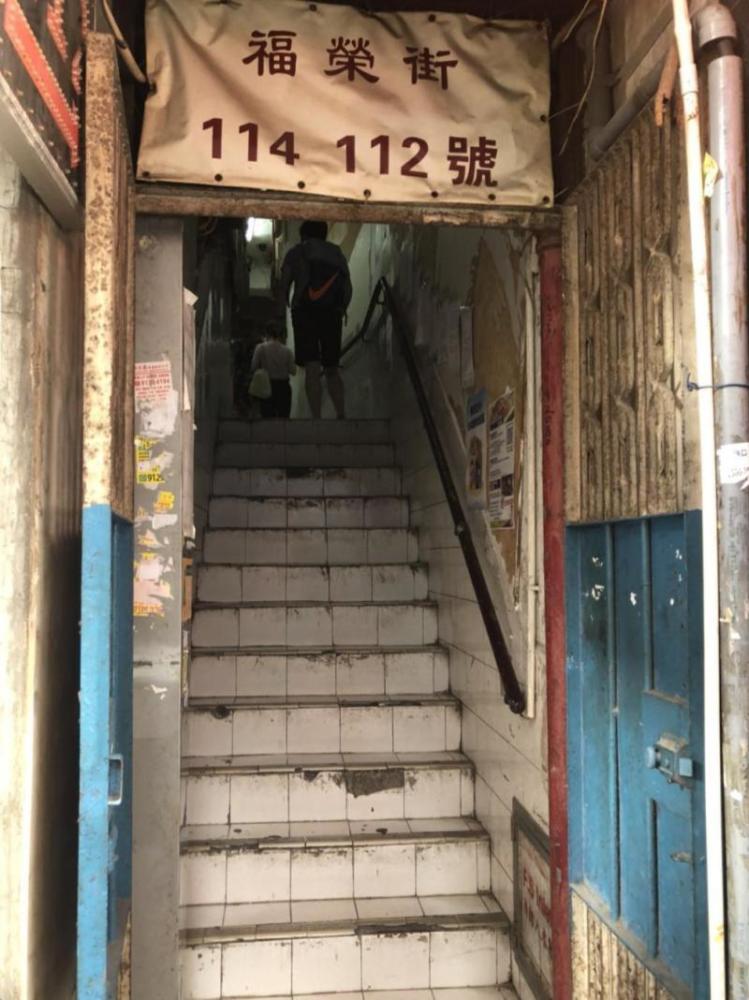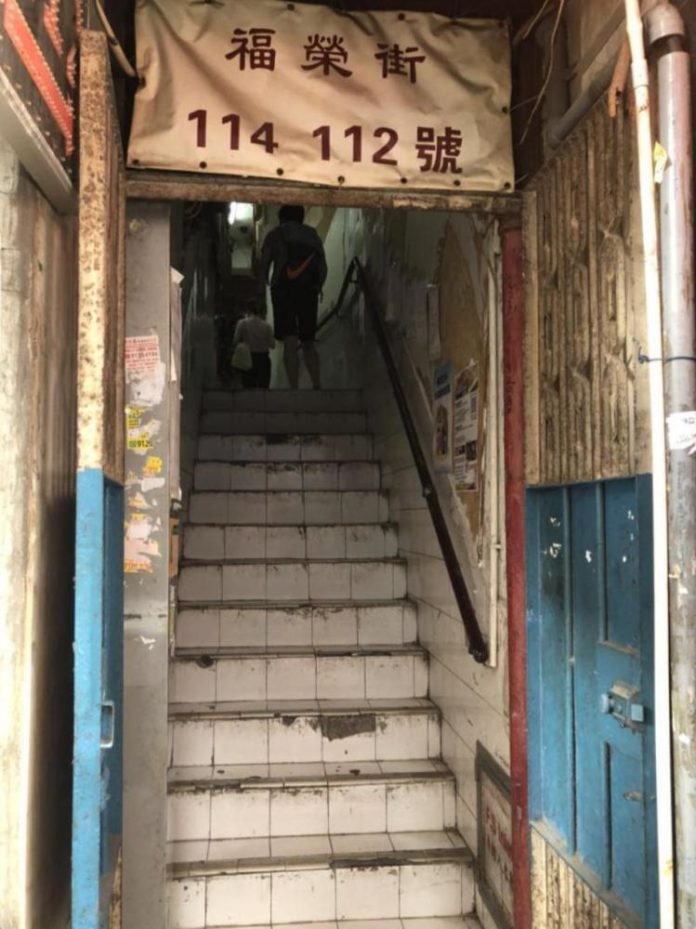In the general textbook, the definition of “Tangfang” is as follows: a residential unit that is divided into several small independent units, which are more common in Tanglou and industrial buildings, and the overall living equipment is poor. Statistics show that there are currently about 210,000 residents in Hong Kong’s Tangfang.

Hong Kong, Kowloon, Sham Shui Po.
The bustling crowds, the old high-rise buildings, and the small shops full of sense of history probably keep the streets of Hong Kong in the 1960s. This is the region with the highest population density in Hong Kong and is said to be the poorest.
“We’re going up from here.” Registered social worker Chen Huiling pointed to a dilapidated narrow doorway at Furong Street. “Her home is on the ninth floor and there is no elevator.”

On July 8, the third round of the new coronavirus epidemic broke out in Hong Kong. One of the cases was near Sham Shui Po. Chen Huiling worried about Ms. Huang, who lived in the Tangfang, decided to come and see. “You must wear a mask.” She solemnly reminded us by the side.
This is a Tang building (an old Hong Kong-style building) built more than 50 years ago. Rusty letterboxes, dark corridors, mottled tiles, and corners of every floor are full of garbage. Follow the social worker layer by layer, we finally climbed to the tenth floor (The second floor of Hong Kong counts as the first floor), like “turning mill”. I leaned against the wall and took off my mask regardless of the air.

The house rented by Ms. Huang is about 10 square meters, and there are few places for outsiders to enter the house. Two beds were placed against the wall, stacked with daily necessities, a writing desk was placed near the window, and the upper space was filled with two rows of closets. The stove and toilet are hidden deep in the room, separated from each other by a curtain. Although the window-type air conditioner buzzed on the side, there was an indescribable sense of heat in the full body.

“Wow…” There was a clear voice from the room next door rushing to the toilet. The 60-square-meter unit was divided into four rooms. Due to the high floors and leaky walls, the landlord gave her a rent that she could accept-more than 3,000 Hong Kong dollars per month.

Ms. Huang from Guangdong and her 9-year-old son are living here. The so-called Hong Kong “husband” has long been missing. As a single mother in a gray area of policy, Ms. Huang chose to “hold on” here. Without employment qualifications, the mother and son live on government relief of 4,620 yuan a month, and pay rent and utilities, leaving a few hundred yuan less to survive.
Chen Huiling gave the mask she brought to Ms. Huang and told her to pay attention to safety. “Today I bought a spare rib and it cost 103 yuan, which is too expensive. I make winter melon pork rib soup for son twice.” This is Ms. Huang’s second soup since last year. She usually cooks noodles and porridge for dinner. Add some greens and ham sausage. A recent epidemic has occurred and she wants to supplement her son’s nutrition.
Ms. Huang said frankly that the prevention and control of the epidemic situation can really be limited. She will take care of her son’s hand washing and hygiene at school, and when he gets home, let him go to the top floor balcony to play alone. In addition, the garbage is thrown downstairs 20 floors up and down every night, and a notice is posted at the door of the mansion: “Please go one step further and put the trash away. There are more and more rats at night. Do you love being next to rats?”
“Not only was it affected by the epidemic, but it was also very depressing last year.” Chen Huiling said that because of fear of being attacked, mainlanders like Ms. Huang did not dare to express their opinions. “She wanted to go back more than once but decided to stay in for the sake of the child.”

“After waiting for 12 years next door, it was finally her turn to move away.” Ms. Huang’s eyes lit up, but she quickly dimmed because she might not even have the qualification to queue. She is even more worried about whether the landlord will increase the price and whether the mother and son can continue to live in this room.
The epidemic is a disaster
Ms. Huang’s encounter is only a microcosm of tenants in Hong Kong. As a charity that mainly serves new arrivals, Chen Huiling, assistant executive officer and registered social worker of the New Home Association, said that in Sham Shui Po alone, the association will serve more than 2,900 households.
It is no exaggeration to say that for these people, the epidemic is a “disaster”. Most tenants in low-income labor-intensive industries, such as retail, restaurants, and construction, are the hardest-hit areas.
Statistics show that the number of people entering and leaving Hong Kong fell by 99% in the first half of the year, and a third of the retail industry driven by overseas tourists entered the cold winter. The slightly improved restaurant industry, because the third round of outbreaks once again triggered the government’s “restriction order”. As for the construction industry, many construction sites are at a standstill because materials cannot be transported in.
In June, the SAR government announced an unemployment rate of 5.9%, a record high of more than 15 years. “(Tangfang tenants) Many people earn less than half of their income or even zero income.” Chen Huiling said. Therefore, some people cannot afford to rent a house in Sham Shui Po, and either move to a farther place or live on the streets. In the past, homeless people could stay overnight at McDonald’s, but some stores were no longer open 24 hours during the epidemic, so even “McRefugees” could not be taken.

Even if you can continue to live in the house, life is not easy. The husband is unemployed at home, the school is suspended, and the children are left at home. Under a small space of 100 feet, there are three or more people in a family all day. Depression, anxiety, disappointment, helplessness, and negative emotions inevitably accumulate. Very often, a little bit of trouble can ignite family conflicts.
Fortunately, there are also examples of family mutual assistance. 25-year-old Liu Yuanchao lives with his mother and brother in a 100-foot Tangfang in Fuhua Street, Sham Shui Po. The monthly rent is more than 4,500 yuan. “I earn my own living expenses,” said the young man who studied at Fujian Overseas Chinese University. He used a skill to run a guitar training class and also opened restaurants near the school. The current wish is that after graduating from the master’s degree, I will save for the down payment to buy a house and help the family move out of the Tangfang.

Like Ms. Huang, Ms. Liu is a new immigrant from the mainland. “Hong Kong does not perform as well as in TVB dramas.” Chen Huiling said that the association has set up inland service offices in Guangzhou, Shenzhen, Quanzhou, Shanwei, and Jiangmen, mainly to help mainlanders who come to Hong Kong to understand the facts of Hong Kong. In fact, it is to control their expectations for the future.

Social workers can do very limited
The two refrigerators in a conspicuous place are the few new items in Ms. Huang’s room. “This is our association to help her purchase.” Chen Huiling introduced that day in order to move this big guy to the ninth floor, several people were busy for an hour.

In the New Home Association Kowloon West Service Office on the first floor of Nanyang Building in Sham Shui Po, there is a dedicated “Caring Fund-Home Improvement Program for Low-income Households”. This plan formulated by the Social Welfare Department of the SAR Government entrusts social organizations including the New Home Association to promote it. Eligible households can apply for non-cash subsidy projects, such as pest control, rodent control, furniture, and home appliance repairs, and purchase of necessary daily necessities. The amount is a maximum of 8,500 yuan for a Hong Kong resident. With the help of the plan, Ms. Huang applied for a refrigerator with the assistance of social workers.
“From July 2, we have received more than 60 applications.” Chen Huiling introduced that to complete a case, social workers have to go to the tenant’s house at least twice. The first time is to evaluate the rationality of the application to see if it is the tenant’s most urgent life needs; the second time is to check the effect to see if it can effectively improve the quality of life. With this refrigerator, Ms. Huang can eat the bought ribs in cold storage twice, which relieves her urgency.

“They are the lowest-level people in society and have been hit hardest by the epidemic, but few people have the patience to listen to their voices.” What Chen Huiling and social work partners can do is to do everything in their power to help the tenants to improve their lives and integrate into society. But it must also be admitted that under the current poor overall environment in Hong Kong, social workers can actually do very limited things.
“In addition to the high floors, I am satisfied with the house.” Ms. Huang comforted herself like this, some sisters lived smaller than her, and the toilet and kitchen were shared. She did not dare to have any extravagant desires, but just hoped that the epidemic situation would be opened and closed as soon as possible in Guangdong and Hong Kong, and it would be more convenient for the staff to come and go.
Leaving her home, the streets of Hong Kong in the evening were filled with fireworks, but a depression felt for a long time and could not dissipate. Yes, the tenant of the house should not be forgotten in the prosperous world under the bright colors of the city.


[…] The Hong Kong Tangfang in Epidemic, Poor Citizens Are Distressed […]
[…] The Hong Kong Tangfang in Epidemic, Poor Citizens Are Distressed […]
[…] The Hong Kong Tangfang in Epidemic, Poor Citizens Are Distressed […]
[…] The Hong Kong Tangfang in Epidemic, Poor Citizens Are Distressed […]